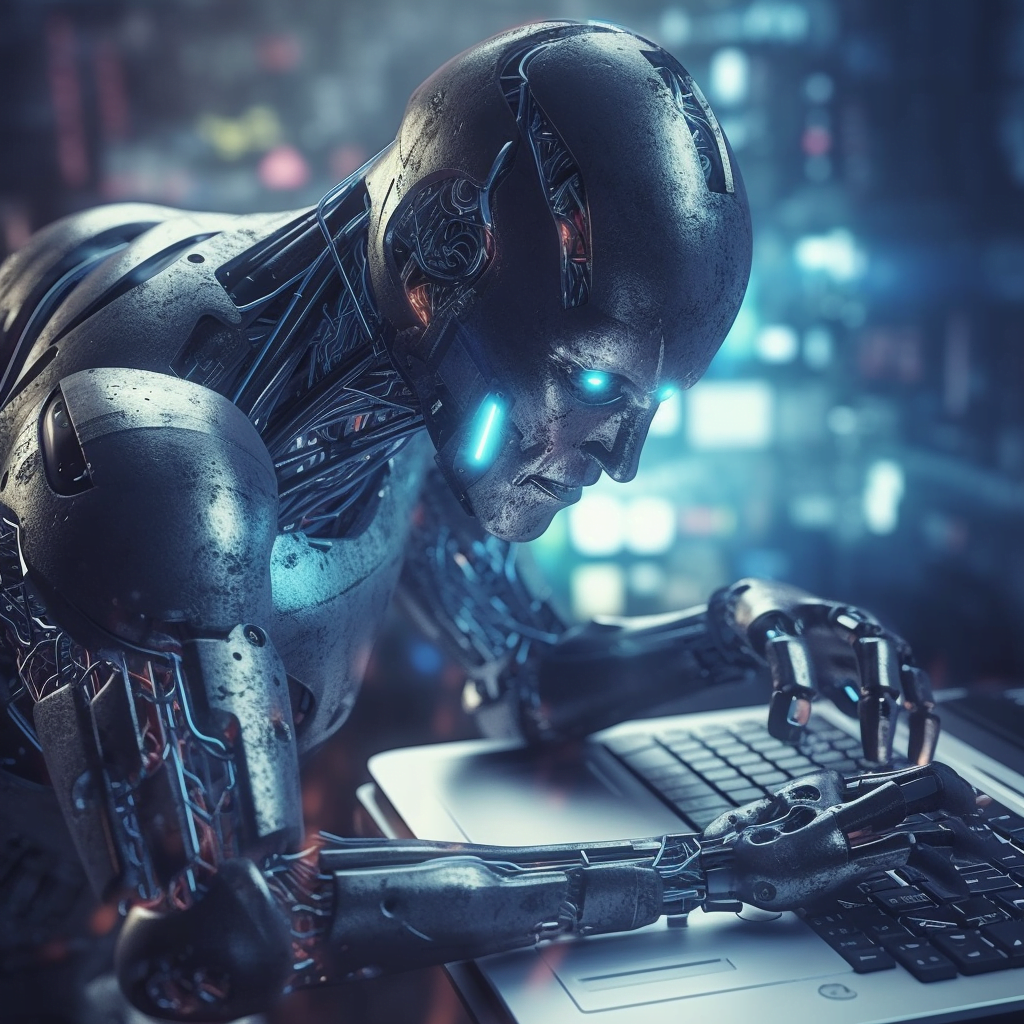
You’ve probably heard a lot about machine learning in the news lately. But what is it and how does it work?
Well, let’s run through a fun beginner’s guide to the complex computerized term!
Imagine you’re at a party and a magician walks in, ready to astound everyone with his tricks. He pulls a rabbit out of a hat, does some card tricks, and suddenly everyone’s amazed.
Now, imagine the magician is a computer, the party is life, and the tricks?
Well, they’re all possible thanks to Machine Learning (ML). Let’s dive into the fascinating world of Machine Learning and find out how it all works.
What is Machine Learning Anyway?
Before we make anything disappear, let’s start with the basics.
Before we plunge into the rabbit hole, let’s start with the fundamentals. What exactly is this enchanting art known as Machine Learning?
At its core, Machine Learning is a branch of artificial intelligence (AI) where a computer system learns and evolves based on its experiences, mirroring the way humans learn. Picture it as a young magician starting his journey in the world of magic.
Sounds quite magical already, doesn’t it?
But here’s the catch—instead of learning from fairy tales or pulling rabbits out of hats, these computer systems learn by analyzing massive amounts of data. They extract insights, identify patterns, and then make predictions or decisions—all without being explicitly programmed to perform these tasks.
To truly grasp this, imagine a budding magician dedicated to mastering his craft. He decides to study every magic book ever written, scrutinizing the pages for hidden knowledge and techniques, much like a machine learning model sifts through heaps of data.
With every magic book (or data point), the magician (or model) learns something new—how to make objects disappear, read minds, or predict the future. He integrates all this knowledge, refining his understanding and approach to magic.
Similarly, a machine learning model analyzes its data, learns from it, and refines its algorithms, enhancing its ability to predict outcomes or make decisions. It’s like the model teaching itself new ‘tricks’—not from a magic book, but from the data it consumes.
The Spell of Self-Improvement
Perhaps the most captivating aspect of Machine Learning is its ability to improve over time. Our magician, after performing countless shows, hones his skills and starts creating his own magic tricks. He adapts based on audience feedback, perfecting his art.
This is precisely what machine learning models do—they improve as they process more data, refining their algorithms to make more accurate predictions or better decisions. This self-improvement is what sets Machine Learning apart from traditional programming and is the secret to its ‘magic.’
How Does Machine Learning Work?
Machine Learning is less about magical spells and more about an intricate, fascinating process of understanding patterns and making predictions. It’s like our magician practicing his tricks repeatedly, refining them based on the audience’s reaction until he has the perfect illusion.
Now, let’s pull back the curtain and see how this all happens.
Learning the Tricks
Just as a magician starts with an assortment of tricks, machine learning begins with a collection of data, also known as a training set. This data can be anything—pictures of cats and dogs for an image-recognition model, or customer behaviors for a recommendation system.
In supervised learning, the training set includes both the input data and the correct output. This is equivalent to a magician being shown a trick and its final result, so he can understand how it’s done. The model then uses this training data to learn the relationship between the input and the output.
For example, if our magician-model is trying to predict a person’s preference for magic tricks, it might be fed a training set of audience reactions along with information about whether those individuals ended up enjoying the show.
Recognizing the Patterns
The next step is the actual learning, where the machine learning model starts recognizing patterns and relationships in the data.
This process can be compared to our magician studying his audience’s reactions to various tricks. He might notice that people who laugh a lot during comedic tricks tend to enjoy the entire show. Similarly, a machine learning model might recognize that customers who rate comedy movies highly also tend to watch more stand-up specials.
Machine learning algorithms employ various techniques to do this, such as decision trees, neural networks, and clustering algorithms. The objective is to create a mathematical model or rule that can generalize from the learned data to unseen situations.
The Prediction Phase
The final stage in the process is prediction, where the trained model is now used to predict outcomes for new, unseen data. If our magician-model has been trained well, it will be able to predict, with a certain degree of accuracy, whether a person will enjoy the show based on their reactions to different tricks.
In the case of machine learning, once a model is trained to recognize patterns, it can predict outputs for new data inputs. For instance, a machine learning model trained to differentiate between images of cats and dogs can identify the animal in a new picture it has never seen before.
The Fine-Tuning
A key part of machine learning is not just making predictions but also continuously learning and adapting. If our magician notices that a particular trick isn’t getting the desired reaction, he tweaks it until it’s more successful. Similarly, machine learning models can be fine-tuned based on their performance, using techniques like backpropagation in neural networks or boosting in decision trees.
This fine-tuning happens iteratively, as more data is collected, enabling the model to improve its predictions over time, just like our magician becoming more skilled at astonishing his audience.
The Different Types of Machine Learning
Our magician has different tricks for different audiences, much like machine learning which has various types for a variety of tasks. These types are like the magician’s assistants, each playing a unique role in the grand act.
Supervised Learning
In the world of magic, an apprentice learns tricks from the master, just like in supervised learning, the model learns from labeled data.
But what does labeled data mean?
Imagine you’re teaching a child to recognize animals. You show them a picture of a dog and say, “This is a dog.” Here, the image is the data and “dog” is the label. Similarly, in supervised learning, the model is given data (the input) with corresponding labels (the correct output).
For instance, to build a spam detection system (a magician’s trick to reveal hidden spam), the model would be fed a large number of emails, each labeled as ‘spam’ or ‘not spam.’ By studying these examples, the model learns to identify which features make an email spam, much like the magic apprentice learning to perform a trick by watching the master.
Unsupervised Learning
Ever heard of self-taught magicians? They learn tricks by experimenting, often not knowing the result beforehand. Unsupervised learning is just like that—the model is given a pile of unlabeled data and left to discover patterns and relationships on its own.
To illustrate, let’s imagine a magician who wants to group his audience based on their reactions to his tricks but doesn’t know how many groups there should be.
An unsupervised learning model would analyze the reactions, find commonalities and differences, and then group the audience members accordingly. This can lead to interesting discoveries, like identifying a group that loves card tricks or another that prefers illusions.
Reinforcement Learning
In reinforcement learning, the model is like a magician constantly refining his tricks based on audience reactions. It makes decisions, gets feedback, and then tweaks its strategy to get the best reactions, maximizing its reward.
Imagine a magician trying to escape from a locked box. He tries picking the lock, but it doesn’t work (negative reward). Then he finds a hidden latch and manages to open the box (positive reward). Over time, the magician learns the best escape strategy based on these experiences.
Similarly, a reinforcement learning model learns by interacting with its environment. For example, in a game of chess, the model decides on a move (action), which leads to a new board setup (state), and it either wins points (reward) or not. The model’s goal is to learn the best strategy that maximizes the total reward.
From the patient apprentice of supervised learning to the daring experimenter of reinforcement learning, these ‘assistants’ perform their unique roles, creating the delightful magic show that is Machine Learning. Each method has its strengths and is used for different types of tasks, providing us with a wide array of magical feats in the real world.
Applications of Machine Learning
Now that we’ve revealed some secrets of our magician, let’s talk about the grand finale. Here are some real-world ‘magic tricks’ enabled by machine learning:
- Recommendation Systems: Ever wondered how Netflix knows what movie you’d like to watch next? Or how Amazon always suggests the right product? That’s the magic of machine learning!
- Spam Filters: Your email inbox staying clear of junk mail isn’t just luck—it’s machine learning at work, separating the spam from the important stuff.
- Image Recognition: From Facebook tagging you in photos to self-driving cars recognizing pedestrians, machine learning models are getting pretty good at understanding images.
- Speech Recognition: Virtual assistants like Siri, Alexa, or Google Assistant wouldn’t be possible without machine learning. They learn from millions of voice samples to understand and respond to our commands.
- Autonomous Vehicles: Self-driving cars use machine learning to recognize obstacles, navigate, and obey traffic rules, making commutes safer and more efficient.
- Fraud Detection: Machine learning is utilized by financial institutions to identify patterns that might indicate fraudulent transactions. These systems can provide real-time alerts and prevent considerable losses.
- Healthcare Diagnosis: Machine learning is revolutionizing healthcare by predicting diseases based on patterns in patient data, interpreting medical images, and personalizing treatment plans.
- Sentiment Analysis: Companies use machine learning to interpret customer feedback, reviews, and social media comments. It can identify patterns and sentiments, helping businesses better understand their customers.
- Churn Prediction: Machine learning can predict customer churn by recognizing patterns in customer behavior and engagement. Businesses can use these insights to improve customer retention strategies.
- Stock Market Trading: Algorithms powered by machine learning are used to analyze market trends and make investment decisions in real-time, optimizing the financial return.
- Natural Language Processing (NLP): Machine learning helps in understanding and interpreting human language, enabling functions like language translation, grammar checking, and even writing articles.
- Weather Forecasting: Machine learning models use historical climate data and patterns to predict future weather conditions with higher accuracy.
- Smart Homes: Machine learning is used to automate home systems like heating, lighting, and security. These systems learn from your habits and adjust to your needs, increasing comfort and efficiency.
- Facial Recognition: From unlocking your smartphone to identifying suspects in security footage, machine learning algorithms are becoming increasingly skilled at recognizing faces.
- Precision Agriculture: Machine learning can predict crop yields, identify pests or diseases, and automate irrigation systems, transforming the way we farm.
- Content Moderation: Machine learning helps social media platforms and online communities by filtering out inappropriate or harmful content, based on learned patterns of unacceptable behavior.
- Predictive Maintenance: Industries are using machine learning to predict machinery breakdowns and schedule maintenance, minimizing downtime and costs.
- Social Network Filtering: Platforms like Facebook and LinkedIn use machine learning to personalize what you see in your feed based on your interactions and preferences.
- Drug Discovery: Machine learning algorithms can analyze chemical compounds and predict their interactions, speeding up the process of drug discovery.
- Virtual Reality: Machine learning plays a vital role in creating interactive, realistic virtual reality experiences by processing and interpreting vast amounts of data.
- Music and Movie Creation: Machine learning is being used to compose music and assist in movie production, offering a whole new level of creativity and innovation.
- Video Game AI: Machine learning is transforming the gaming industry by creating more intelligent, adaptive AI opponents that learn from player’s actions.
The Future of Machine Learning
Machine Learning, like any good magic trick, continues to evolve and astound us. It’s being integrated into healthcare for disease prediction, finance for risk analysis, and even in agriculture for crop prediction. The possibilities seem endless.
As we uncover more of machine learning’s secrets, we’re pushing the boundaries of what we thought was possible. And just like that magician at the party, machine learning continues to captivate us with its potential for transforming our world.
And there you have it—the magic of Machine Learning unveiled! Next time you’re at a party, you can be the one amazing everyone with your knowledge of this incredible technology. Just remember, no need for a top hat or a magic wand. The real magic is in the learning.




